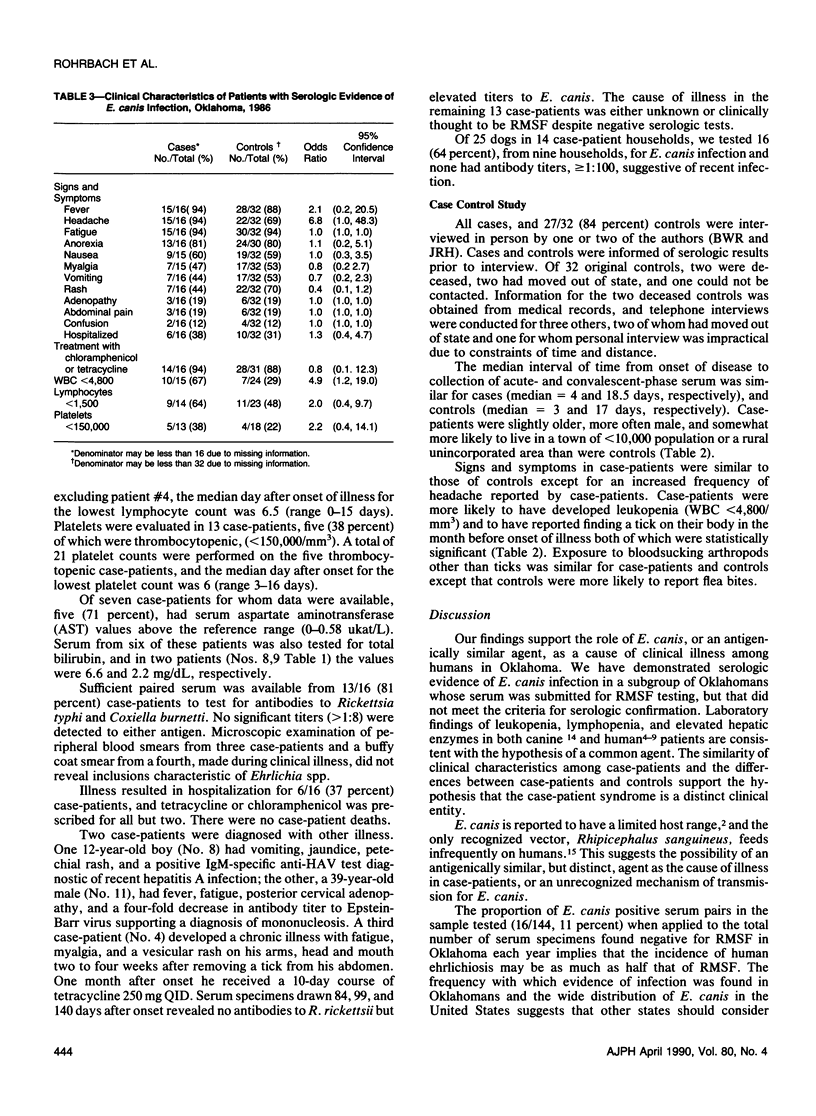Abstract
The results of a serosurvey of Oklahomans for the presence of antibody to Ehrlichia canis is reported. Paired serum specimens, from patients lacking the serologic criteria for diagnosis of Rocky Mountain spotted fever (RMSF), were tested. A four-fold increase in E. canis-IFA antibody was found in 16/144 (11 percent) of these paired serum samples. Patients with serologic evidence of E. canis infection had a mean age of 34 years, 69 percent were male, and 63 percent lived in a town less than 10,000 population. Signs and symptoms included: fever 94 percent, headache 94 percent, fatigue 94 percent, anorexia 81 percent, nausea 60 percent, and rash 44 percent. When compared to control patients, whose sera were submitted for RMSF testing but did not meet serologic criteria for RMSF or E. canis, case-patients were more likely to have had leukopenia (OR = 4.9, 95 percent Cl = 1.2, 19.0) and tick exposure (OR = 9.5, 95 percent Cl = 1.4, 62.7). The results suggest E. canis, or a closely related agent, is a cause of human illness. Ticks are probable vector.
Full text
PDF



Selected References
These references are in PubMed. This may not be the complete list of references from this article.
- Fiset P., Ormsbee R. A., Silberman R., Peacock M., Spielman S. H. A microagglutination technique for detection and measurement of rickettsial antibodies. Acta Virol. 1969 Jan;13(1):60–66. [PubMed] [Google Scholar]
- Fishbein D. B., Sawyer L. A., Holland C. J., Hayes E. B., Okoroanyanwu W., Williams D., Sikes K., Ristic M., McDade J. E. Unexplained febrile illnesses after exposure to ticks. Infection with an Ehrlichia? JAMA. 1987 Jun 12;257(22):3100–3104. [PubMed] [Google Scholar]
- Keefe T. J., Holland C. J., Salyer P. E., Ristic M. Distribution of Ehrlichia canis among military working dogs in the world and selected civilian dogs in the United States. J Am Vet Med Assoc. 1982 Aug 1;181(3):236–238. [PubMed] [Google Scholar]
- Kuehn N. F., Gaunt S. D. Clinical and hematologic findings in canine ehrlichiosis. J Am Vet Med Assoc. 1985 Feb 15;186(4):355–358. [PubMed] [Google Scholar]
- Maeda K., Markowitz N., Hawley R. C., Ristic M., Cox D., McDade J. E. Human infection with Ehrlichia canis, a leukocytic rickettsia. N Engl J Med. 1987 Apr 2;316(14):853–856. doi: 10.1056/NEJM198704023161406. [DOI] [PubMed] [Google Scholar]
- Pearce C. J., Conrad M. E., Nolan P. E., Fishbein D. B., Dawson J. E. Ehrlichiosis: a cause of bone marrow hypoplasia in humans. Am J Hematol. 1988 May;28(1):53–55. doi: 10.1002/ajh.2830280111. [DOI] [PubMed] [Google Scholar]
- Philip R. N., Casper E. A., Ormsbee R. A., Peacock M. G., Burgdorfer W. Microimmunofluorescence test for the serological study of rocky mountain spotted fever and typhus. J Clin Microbiol. 1976 Jan;3(1):51–61. doi: 10.1128/jcm.3.1.51-61.1976. [DOI] [PMC free article] [PubMed] [Google Scholar]
- Ristic M., Huxsoll D. L., Weisiger R. M., Hildebrandt P. K., Nyindo M. B. Serological diagnosis of tropical canine pancytopenia by indirect immunofluorescence. Infect Immun. 1972 Sep;6(3):226–231. doi: 10.1128/iai.6.3.226-231.1972. [DOI] [PMC free article] [PubMed] [Google Scholar]
- Taylor J. P., Betz T. G., Fishbein D. B., Roberts M. A., Dawson J., Ristic M. Serological evidence of possible human infection with Ehrlichia in Texas. J Infect Dis. 1988 Jul;158(1):217–220. doi: 10.1093/infdis/158.1.217. [DOI] [PubMed] [Google Scholar]


